Site Map including locations where photos were taken and site boundaries (Source: https://maps.google.com)
When walking amongst the towering structures that make up downtown Boston, it is hard to believe that there was ever any natural environment to speak of. The cold brick and stone buildings are prime examples of human ingenuity, but the result is an environment far from anything which we would consider natural. So the question remains, what “natural processes” could possibly be found in such a man-made environment? The truth is that there are in fact many natural processes within the confines of this extreme urban environment, they’re just a little harder to spot than processes at a place such as Yellowstone National Park.
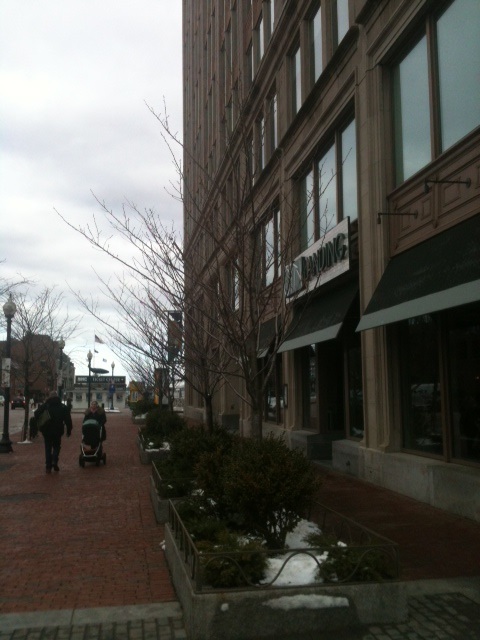 Figure 1 (Source: Personal Photo)
Figure 1 (Source: Personal Photo)The most obvious natural processes which can be observed within the city lies within the presence of trees. The trees on my site did not sprout naturally, but instead, were strategically planted. Nonetheless, the reaction of the trees to the environment in which they were placed is in fact a natural process and can tell us a lot about the conditions of that particular location. While walking around my site, I realized that the tall buildings often resulted in dark sidewalks below. That particular day was quite cold, and I found that a warm, sunny sidewalk was hard to come by. It seems that the street trees in the area were suffering from the same problem and their struggles were noted in my observations. The tree seen in Figure 1 is located on the north side of a building at the beginning of Long Wharf. Upon close inspection, it can be seen that the branches on the street side of the tree stretch out farther than those on the building side. This action is a direct result of a lack of sunlight against the building. Figure 2 depicts another view of the same set of trees, this time with all of their leaves which better depicts the results of lack of sunlight. It is clear from this view that the trees nearest to the curb are much larger than the trees planted closest to the building. I suspect that the large difference in size is primarily due to the fact that sunlight is more plentiful at the curb than it is at the base of the building. As a result, the growth of the trees closer to the building is greatly inhibited. Another contributing factor to the difference in size may be the difference in available soil. The trees nearest the building seem to be planted in shallow beds built directly on top of the sidewalk. If this is true, the trees’ root systems are severely limited which prevents them from reaching their full growth potential. The trees nearest the curb certainly aren’t in an ideal environment either; however, it seems that the sidewalk bricks are laid in sand which means it is possible that these trees have access to a larger amount of soil than what is visible on the surface. The additional soil allows the root systems to develop to a much greater extent than the trees in the shallow beds. The larger root systems provide access to more water and nutrients thus increasing the growth rate of these trees. On page 171 of The Granite Garden, Spirn states that “in the city the average lifetime of a street tree planted today may be only ten years”. In their current environments, it is likely that all of the trees seen in Figure 2 will suffer a similar fate.
Figure 2 (Source: https://maps.google.com)
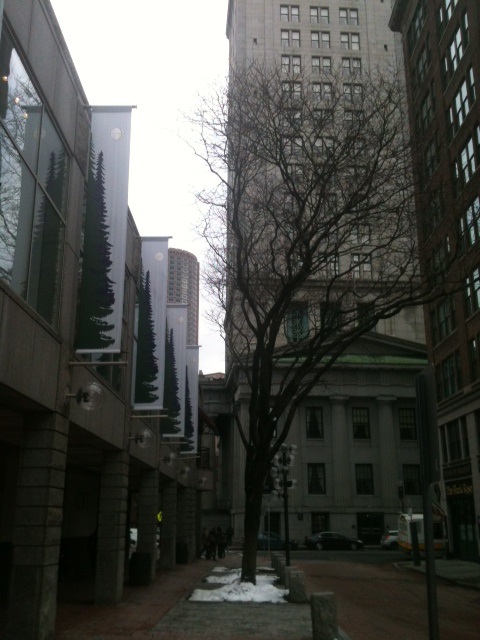 Figure 3 (Source: Personal Photo)
Figure 3 (Source: Personal Photo)Further exploration of my site revealed a few trees which had defied the odds and survived beyond their expected lifespan. Figure 3 depicts three rather large trees on Commercial Street just north of the Custom House (seen in background). The trees have been trimmed by Boston city workers, but still it can be seen that the trunk of the tree is leaning ever so slightly away from the building in an effort to reach more sunlight. As can be seen in the photo, the sky to the southeast of the trees is largely unobstructed. This means that the trees likely see a fair amount of sun beginning shortly after sunrise and lasting until the early afternoon, a significant increase from the trees we saw in Figure 2. Once again, a view of the same trees with a full canopy of leaves reveals another survival strategy which has helped these trees prosper in such an inhospitable environment. In Figure 4 you can see that there are a very small amount of leaves on the lower portions of the trees. Instead the leaves are concentrated at the tops of the trees, above the roofline of the neighboring building. Again, the tree has adapted to its shady environment by reaching upwards and extending its leaves out of the shadows as much as possible. Another detail to note is that the soil base in which these trees are planted is very similar to the soil base of the trees near the curb in Figure 2. Similarly, I suspect that this set of trees has access to a larger volume of soil than what is seen at the surface which would contribute greatly to their successful growth.
Figure 4 (Source: https://maps.google.com)
Another issue for trees in an urban environment is the lack of clean air. Pollutants and dirty air can be detrimental to the health of street trees and my site was no exception. Through an online exploration of my site I began to notice a trend with the location of unhealthy or dead trees. Trees at the west end of my site such as those shown in Figure 4 seemed generally healthy and the same was true for trees on the east side at the Long Wharf. On the other hand, I found multiple dead trees when I directed my attention to the Rose Kennedy Greenway. At first, I found it ironic that the dead trees were located within the only portion of my site designated as a “park”. I would have expected the park area to have the biggest, greenest, lushest vegetation around but instead it was the only place within my site where I found dead trees. Figure 5 shows a single dead tree and Figure 6 shows only two of a set of four adjacent trees all of which were dead at the time of this photo. For a long while I could not figure out what was leading to the death of these trees in particular. The trees are in an excellent location for sunlight, and the perfectly manicured lawn indicates that the Rose Kennedy Greenway is shown a great deal of care and maintenance. As I pondered over the Greenway, I began to think about its origins and the process of the Big Dig and suddenly it occurred to me that, despite the burial of the main artery, the Greenway was still bordered on both sides by two major roads: Atlantic Avenue and John F Fitzgerald Surface Road. This roadway continues to see significant amounts of traffic and I suspect that the dead trees are a result of excess pollution from the high concentration of vehicles that pass literally within feet of these plants. It should be noted that the death of the five trees within the Greenway could also be the result of a disease localized to this particular species of trees. On page 180 of The Granite Garden, Spirn says, “entire streets may be quickly stripped of trees by a single blight”. This may in fact be what is being seen in the Greenway seeing as all of the dead trees are indeed the same species. Nevertheless, I simply consider this a strong possibility to note and stand by my opinion that the death of the trees was caused by the polluted air resulting from high traffic concentrations.
Figure 6 (Source: https://maps.google.com)
A lot can be learned from comparing the differences of various trees within my site, but sometimes no differences at all can teach us something as well. Figure 7 shows a section of State Street (facing east) with trees on either side. State Street runs east-west through my site which means the trees on the left receive a significant amount of sunlight whereas the trees on the right spend the majority of their time buried in the shadow of the building seen directly behind them. Now, everything I’ve learned so far tells me that in identical situations, with identical trees, I should expect the trees which receive more sunlight to be significantly larger than the others. Interestingly enough, the trees in this photo look to be of similar size and health. In this case it is important to realize that the growth of these trees is a function of soil, water, nutrients, sunlight, clean air, and possibly even more parameters. With this in mind and taking a second look at the photo we realize that sunlight must not be the limiting factor of the growth of these trees. For instance if the growth of these particular trees is limited by a lack of available water or nutrients, then the amount of sunlight on either side of the street will not result in any noticeable size differences.
Figure 7 (Source: https://maps.google.com)
Whereas, in the last case sunlight had no effect on the growth of the trees, this final case is an example where the presence or lack of sunlight determines the existence of trees and plant life altogether. Figure 8 is a view of the southern facing side of the Long Wharf. This portion of the wharf is almost always in direct sunlight and as a result, it is filled with plants and trees. Figure 9 is another photo of the same exact wharf, the only difference being that the photo now shows the northern side of the wharf. This side of the wharf is the exact opposite to the southern side in that it almost never sees sunlight. The consequences are clear as you can see that the northern side of the wharf is barren of any plant life whatsoever.
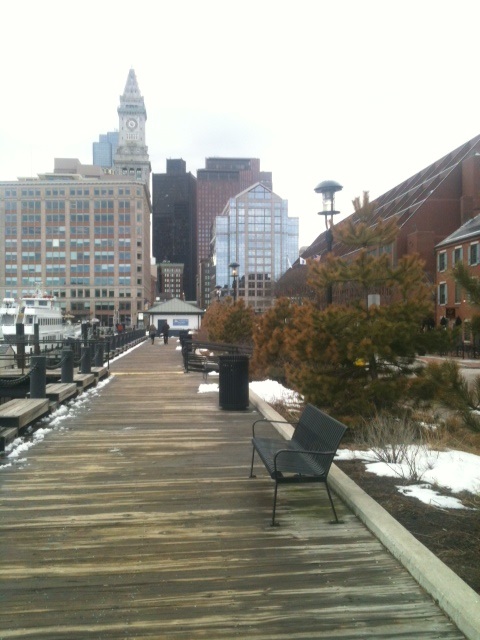
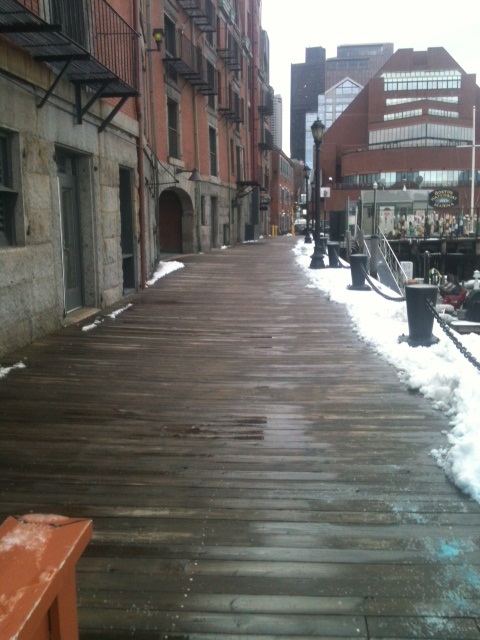 Left: Figure 8 (Source: Personal Photo) Right: Figure 9 (Source: Personal Photo)
Left: Figure 8 (Source: Personal Photo) Right: Figure 9 (Source: Personal Photo)
While taking the photos for Figures 8 and 9, I realized another natural process which I hadn’t previously thought of. The temperature that day was already quite cold and the wind gusts at the end of Long Wharf were almost unbearable. For the first time, I realized the incredible amount of wind that sweeps across the end of Long Wharf. Not only that, but I realized that the wind also played a major factor in what kind of plant life was present. A quick glance at Figures 7 and 8 reveal that the tree types do vary widely from Long Wharf up to State Street. I assume that this variation is due to the fact that the shorter, stubby trees and shrubs found on Long Wharf are better suited to withstanding high wind speeds. The taller trees that we find farther up State Street would likely topple over under the forces brought about by high wind speeds. For that reason, they are better suited farther inland where the large structures of downtown Boston can help shield them from the heavy winds. Another issue brought up by Spirn on page 178 of The Granite Garden is the fact that “gusty winds dehydrate both tree and soil”. Thus, I would conclude that the short stubby trees on the Long Wharf are probably better suited to dry conditions that the larger trees simply cannot handle.
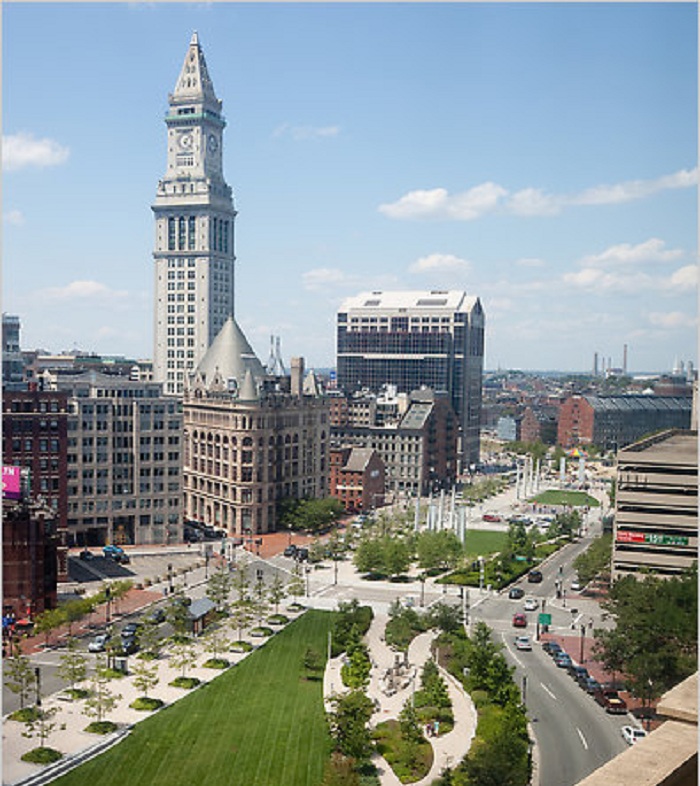 Rose Kennedy Greenway (Source: NY Times)
Rose Kennedy Greenway (Source: NY Times)Although trees may go somewhat unnoticed amidst the towering structures of downtown Boston, leave no doubt that they are there. They are constantly struggling to survive in a man-made environment not suited at all to serve their needs. They are starved of nutrients, water, and sunlight, and constantly challenged by strong winds and polluted air. Nevertheless, the trees remain despite man-kind’s misguided efforts to support them, and through their survival (or death) we can see the effects of the environment in which they live; the environment which we created; and hopefully, the environment which we will learn from and continue to improve.
Bibliography
DigitalGlobe, GeoEye, MassGIS, Commonwealth of Massachusetts EOEA, Sanborn, & USDA Farm Service Agency, (Photographer). (2013). Map of Long Wharf, Boston. [Image of photograph]. Google. Retrieved February 25, 2013, from https://maps.google.com
Google Inc., (Photographer). (2009). Figure 2. [Image of photograph]. Google. Retrieved February 25, 2013, from https://maps.google.com
Google Inc., (Photographer). (2009). Figure 4. [Image of photograph]. Google. Retrieved February 25, 2013, from https://maps.google.com
Google Inc., (Photographer). (2009). Figure 5. [Image of photograph]. Google. Retrieved February 27, 2013, from https://maps.google.com
Google Inc., (Photographer). (2009). Figure 6. [Image of photograph]. Google. Retrieved February 27, 2013, from https://maps.google.com
Google Inc., (Photographer). (2009). Figure 7. [Image of photograph]. Google. Retrieved February 27, 2013, from https://maps.google.com
Jacobs, E. (Photographer). (2011). Rose Kennedy Greenway. [Image of photograph]. New York, New York; The New York Times Company. Retrieved February 17, 2013, from http://travel.nytimes.com/travel/guides/north-america/united-states/massachusetts/boston/46741/rose-kennedy-greenway/attraction-detail.html
Spirn, Anne W. The Granite Garden: Urban Nature and Human Design. New York: Basic Books, 1984. Print.